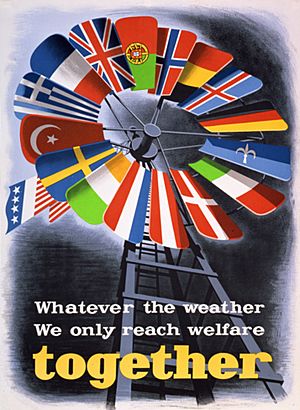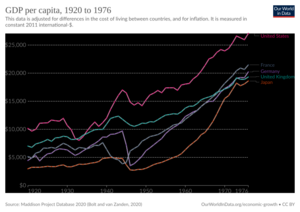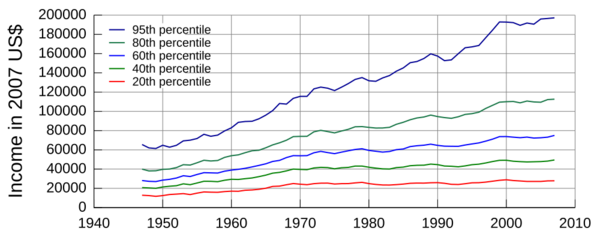Post–World War II economic expansion facts for kids
The post-World War II economic expansion was a time when the world's economy grew super fast. It's often called the postwar economic boom or the Golden Age of Capitalism. This amazing period started right after World War II and lasted until the 1973–1975 recession. Countries like the United States, the Soviet Union, and many in Western Europe and East Asia saw huge and steady growth. Almost everyone who wanted a job could find one.
Even countries that were badly damaged by the war, like Japan (which had its "economic miracle") and West Germany ("economic wonder"), grew incredibly fast. South Korea, France, and Italy also had their own "economic miracles." Even countries not directly hit by the war, such as Sweden, saw big economic improvements.
This boom set the stage for many big changes during the Cold War. People started buying more things, governments created social support systems, and there was a race to space. New ideas like postmodernism and second-wave feminism also became popular.
Contents
When Did the Boom Happen?
Most experts agree that this "Golden Age" of economic growth began around 1950 or 1951. It generally ended in 1973, though some say it might have finished a little earlier, around 1970.
This long period of growth ended because of several important events in the early 1970s:
- The Bretton Woods monetary system, which set global money rules, broke down in 1971.
- US President Richard Nixon stopped letting other countries exchange their dollars for gold. This was called the "Nixon Shock."
- Countries kept trading more and more manufactured goods, like cars and electronics.
- The 1973 oil crisis caused oil prices to jump very high.
- There was a big 1973–74 stock market crash.
- A 1973–75 recession (a time of economic slowdown) followed these events.
While these dates are for the global boom, some countries had their own special growth periods. For example, in Taiwan, the "Taiwan Miracle" continued until the late 1990s. In France, this time is known as the Trente Glorieuses, meaning "Glorious 30 [years]," and it lasted from 1945 to 1975.
How the World Economy Changed
Countries that are part of the OECD (a group of rich countries) saw their economies grow by over 4% each year in the 1950s. In the 1960s, it was almost 5% per year! This was much faster than the 3% growth in the 1970s or 2% in the 1980s.
During the Golden Age, the world's economy grew by about 4.8% each year. Unemployment was also very low in many countries. For example, in the US, it was 4.8%, and in France, it was only 1.2%. This high growth was impressive because only Japan was a big Asian economy growing fast at the time. Later, China's huge growth would boost the global average even more.
Also, during this Golden Age, the gap between rich and poor generally got smaller. This is different from what happened later, when the gap started to grow. The Golden Age was also a time of unusual financial stability. There were far fewer big money problems or crises than before or after this period.
What Caused This Huge Growth?
Many things helped cause this amazing economic boom.
Better Ways to Produce Things
Factories became much more efficient. New technologies like automated controls, which help machines work on their own, became popular after the war. Stores and shops also got better at moving goods thanks to new highways, big warehouses, and equipment like forklifts and shipping containers. Oil started to replace coal in many places, like trains and ships.
Farming also changed a lot after World War II. Farmers began using:
- Chemical fertilizers
- Tractors
- Combine harvesters (machines that harvest crops)
- New types of seeds that produced more food
- Pesticides to protect crops
Government Spending and Ideas
Many economists believe that new government policies helped a lot. These policies were based on the ideas of Keynesian economics. This means governments actively spent money to boost the economy, especially on big projects.
Building New Roads and Bridges
In the United States, President Dwight D. Eisenhower signed a bill in 1956 to build the Interstate Highway System. He said these highways were important for America's safety during the Cold War. The idea was that big cities might be targets in a war, so highways would help people leave quickly and make it easier for the military to move around.
Military Spending
Another idea is that large spending on the military helped stabilize the global economy. This is sometimes called "Military Keynesianism." Also, soldiers returning from WWII had pensions to spend, which boosted the economy.
Fairer Distribution of Wealth
During the World Wars, governments introduced progressive taxation. This meant richer people paid a much higher percentage of their income in taxes. The goal was to share the costs of the war more fairly. Even though tax rates went down a bit after the wars, they stayed much higher than before. This helped spread wealth more evenly.
Also, during and after the war, many countries used rationing. This meant people could only buy a certain amount of scarce goods, like food or fuel, using special stamps. This helped make sure everyone got a fair share.
After the war, these progressive taxes continued. Taxes on inherited money also helped. In Japan and South Korea, high taxes on the rich were common during their fast growth periods.
Low Oil Prices
For many years after the war, oil was quite cheap. In the 1940s and 50s, the price was low. Even during the Vietnam War, it slowly went down. Cheap oil made it cheaper for businesses to produce goods and for people to travel, which helped the economy grow. However, this changed dramatically during the 1973 oil crisis, when oil prices suddenly doubled.
Working Together Globally

After the war, major countries wanted to avoid the mistakes made after World War I, which led to the Great Depression. They decided to work together more. The Marshall Plan was a big part of this. In 1948, the Marshall Plan sent over $12 billion (a huge amount back then!) to help rebuild and modernize Western Europe. This cooperation helped countries recover faster and trade more easily.
New international groups were also formed, like the United Nations and the Bretton Woods monetary system. These groups aimed to keep things stable and promote free trade.
How Different Countries Benefited
The economies of the United States, Japan, West Germany, France, and Italy did especially well. Japan and West Germany even grew to be bigger than the United Kingdom during these years, even though the UK was also doing better than ever before.
France
Between 1947 and 1973, France had a huge economic boom, growing about 5% each year. This period is called Trente Glorieuses (Glorious Thirty). France caught up with the United States in terms of average income. Only Japan grew faster than France during this time. By the 1980s, France became a leading world economic power.
Italy
Italy's economy also boomed in the 1950s and early 1960s, growing at record rates. This was helped by new industries, the rebuilding of cities like Milan and Rome, and aid from the Marshall Plan. This period is known as the "Italian economic miracle."
Japan

After 1950, Japan's economy recovered from the war and started growing faster than any other country. The Korean War helped, as Japan supplied goods to the UN forces. Japan became a major player in making steel, cars, and electronics. People's quality of life improved greatly. However, the high oil prices in 1973 caused Japan's first recession since World War II.
Soviet Union
In the early 1950s, the Soviet Union quickly rebuilt after the war and had a decade of fast economic growth. They made big technological achievements, like launching the first earth satellite. By the mid-1950s, they were among the top countries in terms of money earned per person. However, growth slowed down in the mid-1960s as more money went to military and space projects instead of everyday goods.
Sweden
Sweden was mostly unharmed by World War II. It experienced huge economic growth until the early 1970s. Many people moved to Sweden for work, especially from Finland and other European countries. Cities grew fast, and many new homes were built.
United Kingdom
The UK also felt very prosperous. In 1957, Prime Minister Harold Macmillan famously said, "most of our people have never had it so good." Unemployment was very low during this Golden Age, much lower than before or after. People also reported being much happier during this time.
United States
From the end of World War II to the early 1970s, the US economy grew enormously. The total value of goods and services produced (GDP) jumped from $228 billion in 1945 to almost $1.7 trillion in 1975. By 1975, the US economy made up about 35% of all industrial production in the world!
Money from war bonds was paid back to families, and the G.I. Bill helped soldiers get an education, creating a skilled workforce. The middle class grew a lot, and everyone's income generally increased. This growth was shared fairly among different income groups, partly because labor unions were very strong then. Many people moved from low-paying farm jobs to better-paying jobs in cities.
West Germany

West Germany also saw amazing economic growth starting in the early 1950s. Journalists called it the Wirtschaftswunder or "Economic Miracle." Industrial production doubled from 1950 to 1957, and the economy grew by 9% or 10% each year! This helped the rest of Western Europe grow too. Workers and unions supported new policies, which helped keep strikes low and encouraged new technologies. Aid from the Marshall Plan also boosted the recovery. West Germany became respected again and played a key role in forming the European Economic Community (now the European Union).
What Were the Effects of the Boom?
The post-war economic boom had many big effects on society, culture, and politics. One major effect was the "baby boom," where many more babies were born.
Other changes included:
- The peak of the Cold War
- More people buying things (consumerism)
- The growth of the welfare state (government support for citizens)
- The space race
- New youth cultures, like the "Mods"
- Opposition to the Vietnam War
- The civil rights movement
- The start of second-wave feminism
- A nuclear arms race
In the United States, many middle-class families moved from cities to the suburbs. It was a time when most people could expect a steady job, a house, and a family. There was a lot of optimism that science and technology could solve most of humanity's problems. This hopeful feeling was seen in events like the 1964 New York World's Fair.
Why the Boom Slowed Down
The sharp increase in oil prices during the 1973 oil crisis was a big reason the boom ended. This pushed the world towards a "post-industrial economy," where services became more important than manufacturing. Demand for steel also went down, and Western countries faced more competition from newer industrial countries. This was especially hard for places that relied on mining and steel, like the "Rust Belt" in North America.
See Also












